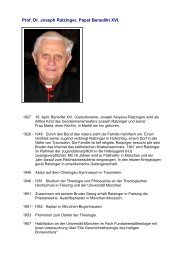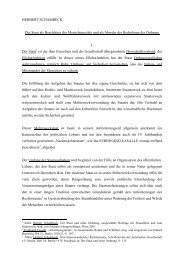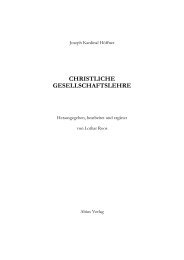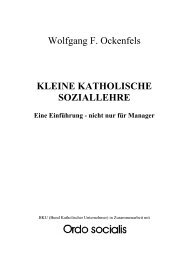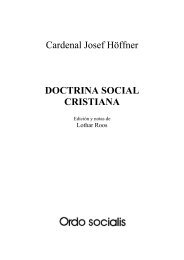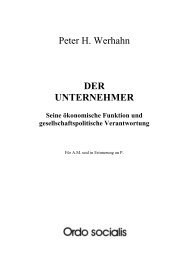Joseph Cardinal Höffner CHRISTIAN SOCIAL ... - Ordo Socialis
Joseph Cardinal Höffner CHRISTIAN SOCIAL ... - Ordo Socialis
Joseph Cardinal Höffner CHRISTIAN SOCIAL ... - Ordo Socialis
Create successful ePaper yourself
Turn your PDF publications into a flip-book with our unique Google optimized e-Paper software.
the family. Its origin is not of the state or society. Against these anti-family utopias Christian<br />
social teaching posits the family as an unrenounceable community of life that has two tasks to<br />
fulfil: care for physical needs and cultivation of spiritual, moral, and religious values. In daily<br />
family life, the two tasks can hardly be separated from each other, since the organization of<br />
the household has simultaneous educational consequences.<br />
1. The Family's Care for Physical Needs<br />
The family naturally grants the child a capital of life and security; it protects him or her from<br />
anxiety and gives him or her leeway, so that he or she can grow in a carefree manner. The<br />
sheltering, protecting, caring, and providing function of the family is of a threefold kind:<br />
a) The common home<br />
The family gives man a house, a dwelling, a home. Since most people perform their professional<br />
work in factories, administrative organizations, offices, and stores they have an especial<br />
need nowadays of a home to return to at the end of the day which offers them peace and privacy.<br />
The architectural structure of the dwelling unit should give genuine expression to the<br />
meaning of the home, though unfortunately this is frequently not the case. In many dwellings<br />
the rooms go off from an often ugly entrance hall, which thus becomes the centre of the<br />
dwelling, so that, sociologically speaking, the family is broken down into its individual members,<br />
each of whom leads his or her own life. Instead of this, the 'nuclear meaning' of the<br />
dwelling must be recognized again and considered in project planning; this will lead to clusterings<br />
of space „that are ordered in horizontal and vertical extension around a central, communal<br />
space.“ In this way, the family is understood as a whole which possesses in its living<br />
room „the meaningful focus of its gathering and development, without hindering the growth<br />
of the individual“(R. Gieselmann) 70<br />
The dwelling may fulfill its function as a home in the form of an occupier owned home as in<br />
the form of a rented dwelling. Whereas for the affluent citizens of the nineteenth century it<br />
was almost disgraceful to start a family before one owned a home, today a certain rhythm of<br />
living has become common. Young married couples usually move into a minimum-sized<br />
apartment; when they are ready to give life to more children, they seek a larger dwelling, often<br />
doing so several times. In old age, when their children are married, the parents again retire<br />
into a smaller dwelling, so that five household arrangements follow one another: the household<br />
of the married couple, the household with small children, the household of the mature<br />
family, the household of the elderly couple, and the final household. Nevertheless, the importance<br />
of a home of one's own for the rootedness and inner cohesion of the family should not<br />
be underestimated. Man is more integrated into the landscape, homeland, community, and<br />
neighborhood through a home of his own than through a rented dwelling. Pius XII emphasized<br />
that „of all the goods that can be private property“ nothing corresponds to nature more<br />
«than the soil, the plot of land, on which the family dwells and from whose fruits it lives<br />
wholly or at least in part.“ The desire for a home of one's own is fortunately strong in all social<br />
strata, even among workers, so that one can speak of a continually expanding movement<br />
to own one's own home, which has nothing to do with social romanticism, but is connected<br />
with the change in awareness of life in the working population and represents an important<br />
step in the social and economic integration process of wage-earners.<br />
b) The common table<br />
The living community of parents with their children finds a particularly intimate expression in<br />
the common table. At the family table, an apportionment is made in a selfless way to each one<br />
according to his or her needs. The small child who does not yet 'bring in' or 'earn' anything<br />
receives everything he or she needs for healthy growth. In this way an understanding is awak-<br />
70 In Werk 41 (1954):8ff.<br />
61




